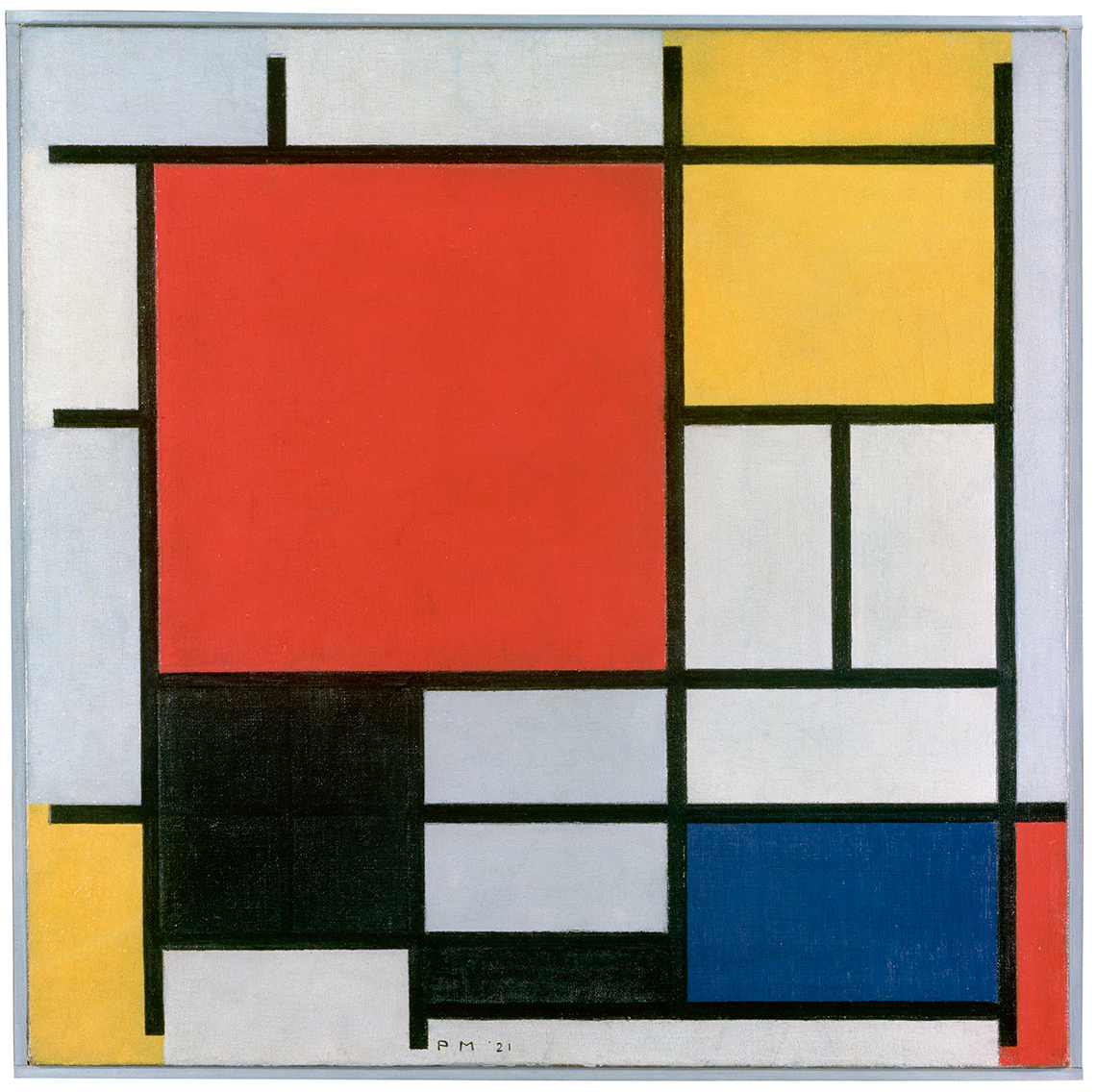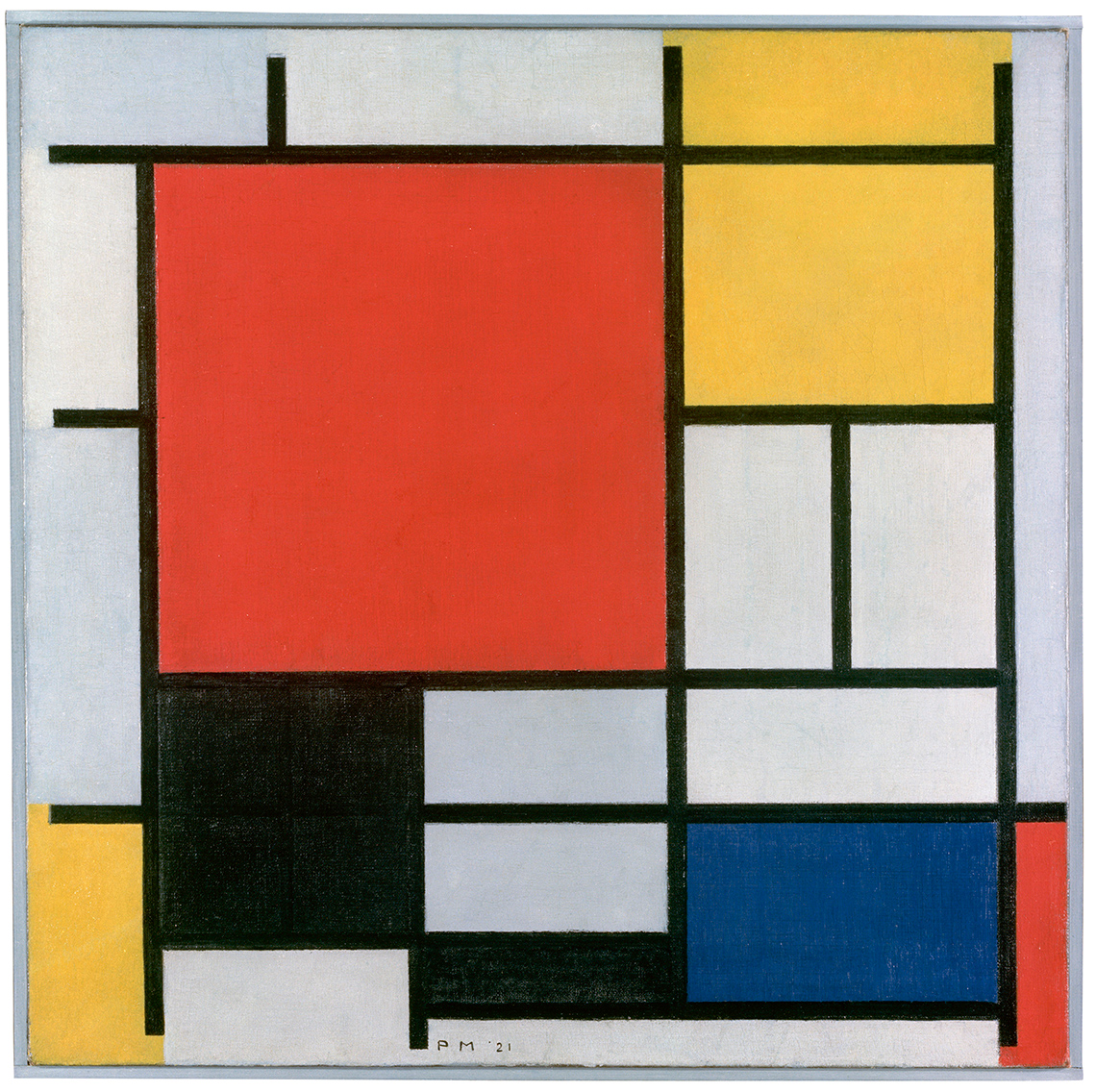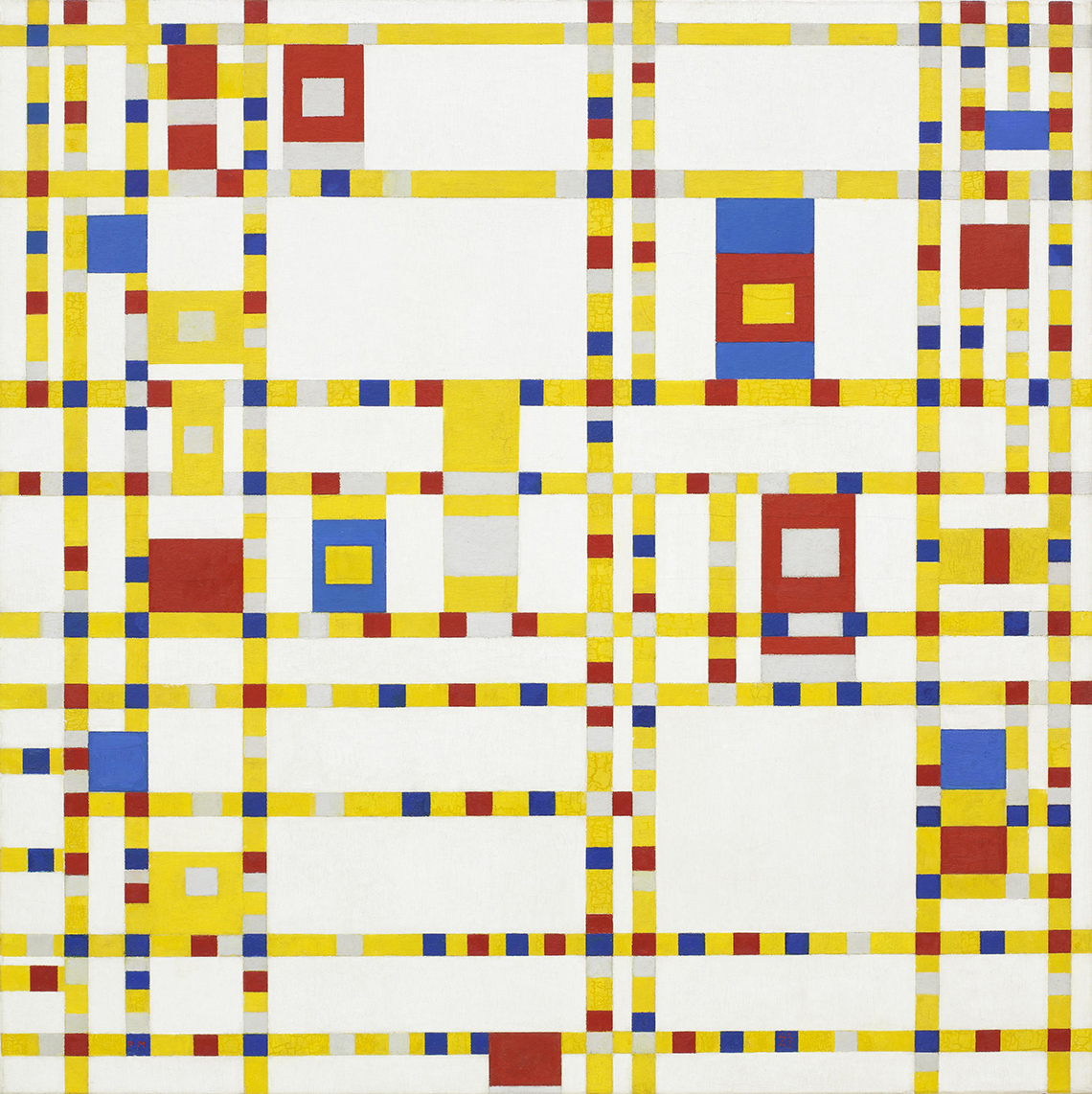Minds On
Let’s get started!
Noticing lines
What types of lines do you notice in the painting?

Composition with Red, Yellow, Blue, and Black by Piet Mondrian, 1921
A painting with straight black lines that go up and down, left and right to make squares and rectangles of different sizes. The squares and rectangles have different colours and shades that include white, black, grey, red, yellow, and blue.
Action
Get ready, get set…
Types of lines
There are lots of different types of lines that artists use.

An anchor chart that describes 9 different lines: straight, diagonal, zigzag, dotted, dashed, wavy, curved, scalloped, spiral. Straight lines are lines that go horizontal or vertical. Diagonal lines are lines that go in a slant. Zigzags are lines that make a lot of sharp turns back and forth. Dotted lines are lines that are formed with a series of circles. Dash lines are lines made out of lines with breaks in them. Wavy lines are lines that bend and curve. Curved lines are lines that bend and change direction. They form arc shapes. Scalloped lines are lines that make a series of half circles. Spiral lines are lines that go around in a circular motion.
Lines also go in different directions.

An anchor chart describing the three different directions lines can go in. The first is horizontal which are lines that go left and right. The second is vertical which are lines that go up and down. The third is diagonal which are lines that go across at a slant or angle.
Let's return to the painting in the Minds On. It was created by the artist Piet Mondrian.
Use the lines chart to choose what kind of lines the artist used. Next, use the line direction chart to choose whether the lines are horizontal, vertical or diagonal.

Composition with Red, Yellow, Blue, and Black by Piet Mondrian, 1921
A painting with straight black lines that go up and down, left and right to make squares and rectangles of different sizes. The squares and rectangles have different colours and shades that include white, black, grey, red, yellow, and blue.
For the first sentence, select the word that describes the type of lines in the painting. For the second sentence, select the word that describes the direction of the lines in the painting.
Piet Mondrian
Piet Mondrian was Dutch painter. He made art using line, shape, and colour.
What shapes do you recognize in the following painting?

Broadway Boogie Woogie by Piet Mondrian, 1942-3
A painting. There are straight vertical and horizontal lines that are yellow that form rectangles and squares of different sizes that are white. The yellow lines are broken down by grey, blue, and red rectangles. There are also bigger rectangles and squares of the different colours all over the painting.
For the sentence, select the missing word or phrase from the drop-down menu.
Colours
Piet Mondrian mostly used the primary colours red, blue, and yellow with black and white.
Primary means first. When we mix two primary colours, we get something called secondary colours.
The following image is an example of what happens when you mix 2 primary colours together.

An anchor chart describing how primary colours can be mixed to make secondary colours. Red and blue make purple. Yellow and blue make green. Red and yellow make orange.
Explore the following painting. Piet Mondrian used:
- colours
- shapes
- lines
Explain what kinds of colours, shapes, and lines Piet Mondrian used to create his painting.

Composition with Yellow, Blue and Red by Piet Mondrian, 1942
A painting. There are straight black vertical and horizontal lines. These lines make white squares and rectangles of different sizes. On the top left corner is a yellow rectangle. On the bottom left side there is a long blue rectangle broken up into smaller rectangles by the straight vertical lines. Near the bottom right corner is a small red rectangle and to the left of it is another larger red rectangle.
Press ‘Answer’ to access the answer to check your understanding.
Line: straight lines that travel in vertical and horizontal directions
Shape: rectangles and squares
Colours: red, blue, and yellow
Consolidation
Putting it all together
Your turn!

Now that you know a little more about the art style of Piet Mondrian and that he used straight lines, squares, and rectangles, as well as primary colours in his paintings it's your turn to try to create your own art. How might you create your artwork to include straight line, geometric shapes and primary colours?
Materials Needed
Materials needed
Possible materials you might need for this activity are:
- a blank sheet of paper or an art journal
- drawing and painting materials such as pencils, paints and paintbrushes, markers, or crayons
- ruler
- an electronic tablet for drawing
- any other art materials you like to use
Always be sure to do your safety checks before you do an activity.
Safety
Before you begin check:
Consider the following options to check out a variety of methods to create your art. Choose one option to try out.
Option 1: Description
Describe how you might create your artwork.
What kinds of lines, shapes and/or colours might you use?
What kind of tools will you use to complete your design?
How will you put your design together? Explain what you would do first, second and third to complete the artwork.
Press the following tabs to access the anchor charts that explains lines, shapes, and colours.

A line is an element of design. A line is the path left by a moving point, such as a pencil or a digital drawing tool. A line is a mark that leads the audience's attention in an artwork. There are five kinds of lines: vertical, horizontal, diagonal, zigzag and curved. A vertical line directs audience's attention to up and down directions and can create a feeling of stability. A horizontal line directs audience's attention to side to side and can create a feeling of balance and calm. A diagonal line directs audience's attention to lean to one side and can create a feeling of movement and unstableness. A zigzag line is made up of connected diagonal lines and can create a feeling of action and energy. A curved line is a rounded line that can be spirals or circles and can create a feeling of flowing movement.

A chart about shapes. A shape is an element of design. A shape is a form that is enclosed or outlined. A shape has length and width. A shape can be created by line, value, colour and/or texture. A shape may be geometric or organic. The three kinds of shapes are geometric shapes, organic shapes, and forms. Geometric shapes are shape with regular edges. For example, a square, a circle and a triangle are geometric shapes. Organic shapes: Organic shapes are free-flowing shapes. They are irregular. They can be found in nature. Examples include a free-flowing wiggle shape. Form is a shape that has three dimensions: height, width, and depth. An example includes a three-dimensional cone and cylinder.

Colour: In science, colour is a part of an object when light bounces off it. The four parts of colour are hue, value, intensity, and being warm or cool. Colours include primary or secondary. The following chart explains how primary colours are mixed to make secondary colours. Red and blue make purple. Yellow and blue make green. Red and yellow make orange.
Option 2: Create your own artwork
Create your own artwork by following the tutorial. You may use any art materials you wish.
Portfolio
Portfolio reflection
Add your artwork or description to your art portfolio and create a story for your art.
- What is happening in your work?
Record your ideas using a method of your choice.
Reflection
How do you feel about what you have learned in this activity? Which of the next four sentences best matches how you are feeling about your learning? Press the button that is beside this sentence.
I feel…
Now, record your ideas about your feelings using a voice recorder, speech-to-text, or writing tool.




